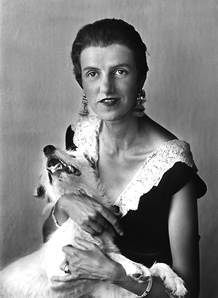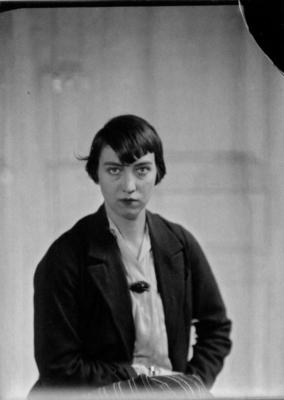In 1918 at age 20, Berenice Abbott borrowed twenty dollars for a train ticket from Springfield, Ohio to Manhattan. She enrolled at the Columbia School of Journalism and dropped out after one week. Sculpture, she decided, would be her métier. “I was scared of New York, scared of America,” she wrote later. “I wasn’t commercial. And America was so commercial, that’s why I left it.” In March 1921, she set sail for Paris, then struggled for two years to study and develop her sculpting, sometimes posing for artists to earn enough francs to live on. In 1923, Man Ray, whom she had met in New York, suggested that she come to work for him as a photo assistant at his Paris studio.
 [Left: Peggy Guggenheim, 1926] She wrote, “Man Ray did not teach me photographic technique. He took the portraits on the balcony while I worked in the darkroom. One day he did, however, suggest that I ought to take some myself; he showed me how the camera worked and I soon began taking some on my lunch break.” Her first photo also was shot from his balcony. She continued, “I would ask friends to come by and I’d take pictures of them. I had no idea of becoming a photographer, but the pictures kept coming out and most of them were good. Some were very good and I decided perhaps I could charge something for my work. Soon I started to build up a little business and I paid Man Ray for the supplies I used, but eventually I was paying him more than he was paying me and that’s when it started to become a problem.”
[Left: Peggy Guggenheim, 1926] She wrote, “Man Ray did not teach me photographic technique. He took the portraits on the balcony while I worked in the darkroom. One day he did, however, suggest that I ought to take some myself; he showed me how the camera worked and I soon began taking some on my lunch break.” Her first photo also was shot from his balcony. She continued, “I would ask friends to come by and I’d take pictures of them. I had no idea of becoming a photographer, but the pictures kept coming out and most of them were good. Some were very good and I decided perhaps I could charge something for my work. Soon I started to build up a little business and I paid Man Ray for the supplies I used, but eventually I was paying him more than he was paying me and that’s when it started to become a problem.”
 [Left: Djuna Barnes, 1926)] Taken aback by how quickly she progressed, Man Ray may have been relieved when Abbott decamped to her own studio at 44 Rue de Bac with support from Peggy Guggenheim. But she owed him a debt of sorts: her photographic attitude seems to have rapidly emerged by way of profound contrast with his work. “He took some fantastic portraits of men,” she said, “but his women are mostly pretty objects. I didn’t think about the male-female thing at the time, but it just turned out the photographs I took were different from his.” Competing with Man Ray, she claimed, was something she avoided – but they were differently oriented from the start. In June 1926, Jan Slivinsky’s Au-Sacre-du-Printemps gallery sponsored her first show with her now famous portrait of James Joyce as well as those of Jean Cocteau, Sylvia Beach, Djuna Barnes, André Gide and others. The following month, Paris Vogue hired her as a part-time photographer and published her first fashion shots.
[Left: Djuna Barnes, 1926)] Taken aback by how quickly she progressed, Man Ray may have been relieved when Abbott decamped to her own studio at 44 Rue de Bac with support from Peggy Guggenheim. But she owed him a debt of sorts: her photographic attitude seems to have rapidly emerged by way of profound contrast with his work. “He took some fantastic portraits of men,” she said, “but his women are mostly pretty objects. I didn’t think about the male-female thing at the time, but it just turned out the photographs I took were different from his.” Competing with Man Ray, she claimed, was something she avoided – but they were differently oriented from the start. In June 1926, Jan Slivinsky’s Au-Sacre-du-Printemps gallery sponsored her first show with her now famous portrait of James Joyce as well as those of Jean Cocteau, Sylvia Beach, Djuna Barnes, André Gide and others. The following month, Paris Vogue hired her as a part-time photographer and published her first fashion shots.
 [Left: Self-portrait] Paris Portraits is the second volume to appear in Steidl’s planned publication of Abbott’s complete works. Covering the years 1929-1967, a five-volume The Unknown Abbott appeared in 2013. The new book collects 83 subjects presented in alphabetical order. Each spread includes the uncropped originals and finished portraits – a display that reinforces Abbott’s prohibition against manipulation of the image. She was quite strict throughout her life about regarding photography solely as a descriptive and documentary art, having proclaimed in 1951, “Photography can never grow up if it imitates some other medium. It has to walk alone. It has to be itself.” The book’s transfers — from her glass negatives to highest-quality matte plates — are finely printed in their original dimensions. She used a 5×7 view camera with a reducing back and glass negatives.
[Left: Self-portrait] Paris Portraits is the second volume to appear in Steidl’s planned publication of Abbott’s complete works. Covering the years 1929-1967, a five-volume The Unknown Abbott appeared in 2013. The new book collects 83 subjects presented in alphabetical order. Each spread includes the uncropped originals and finished portraits – a display that reinforces Abbott’s prohibition against manipulation of the image. She was quite strict throughout her life about regarding photography solely as a descriptive and documentary art, having proclaimed in 1951, “Photography can never grow up if it imitates some other medium. It has to walk alone. It has to be itself.” The book’s transfers — from her glass negatives to highest-quality matte plates — are finely printed in their original dimensions. She used a 5×7 view camera with a reducing back and glass negatives.
The editors maintain that the politicians, Nobel laureates, entertainers, and socialites who came to her studio “were linked in some way socially, intellectually, romantically or artistically” – in other words, people she circulated among. They arrived prepared to be photographed – though of Coco Chanel, Abbott noted, “She arrived with someone else and was not particularly well dressed.” There is an editor’s note, usually merely factual, accompanying each set of portraits.
 When Abbott died at age 93 in 1991, she was celebrated not only as the maker of the iconic Changing New York (1939), but also as the person most responsible for preserving and promoting the legacy of photographer Eugène Atget. Upon his death in 1927, Abbott bought the 1,500 glass-plate negatives and more than 8,000 prints remaining in his studio and brought them to New York in 1929. Perhaps it is no coincidence that the most moving image in Paris Portraits is that of the haggard and ill Atget, wrapped in his coat.
When Abbott died at age 93 in 1991, she was celebrated not only as the maker of the iconic Changing New York (1939), but also as the person most responsible for preserving and promoting the legacy of photographer Eugène Atget. Upon his death in 1927, Abbott bought the 1,500 glass-plate negatives and more than 8,000 prints remaining in his studio and brought them to New York in 1929. Perhaps it is no coincidence that the most moving image in Paris Portraits is that of the haggard and ill Atget, wrapped in his coat.
 “I try not to get too near,” she remarked. “I think if I had longer focal-length lenses, it would have been better … I tried to get them unposed. Who wants a posed photograph?” As a result, the images could be imagined as moments of ongoing exchanges, the gestures personally noticed more than greedily peered at by the camera. There is some diffidence – as when framing an imposing Sylvia Beach in a trench coat who has turned her head sideways, in thought or to look at something to her left. As for Cocteau, always ready to perform for the camera, Abbott was willing to shoot his scenario as he lay in bed with a white plaster sculptured head.
“I try not to get too near,” she remarked. “I think if I had longer focal-length lenses, it would have been better … I tried to get them unposed. Who wants a posed photograph?” As a result, the images could be imagined as moments of ongoing exchanges, the gestures personally noticed more than greedily peered at by the camera. There is some diffidence – as when framing an imposing Sylvia Beach in a trench coat who has turned her head sideways, in thought or to look at something to her left. As for Cocteau, always ready to perform for the camera, Abbott was willing to shoot his scenario as he lay in bed with a white plaster sculptured head.
Hank O’Neal worked closely with Abbott for more than two decades. In his introduction, he recalls an evening they spent together in the late 1970s: “One night I came upon an outline and a modest mockup for a project Abbott had considered at one time. On the first page was a handwritten title, Faces of the 20s. Underneath that title was another idea, Portrait of the Twenties. On the second page was a third variation, Rebels of Paris. … She thought there might be some interest in having a fresh look at the faces of some of the most interested people of the 1920s, but she was about fifty years ahead of her time, as was often the case with one of the most visionary photographers of the Twentieth Century.”
[Published by Steidl on October 25, 2016. 368 pages, $70.00 large format hardcover]